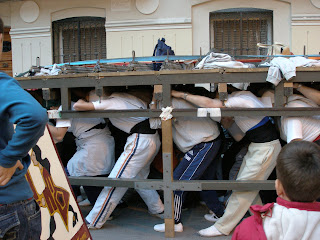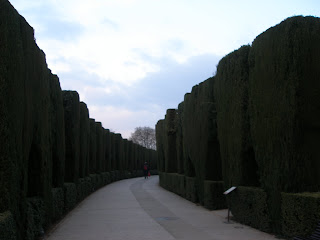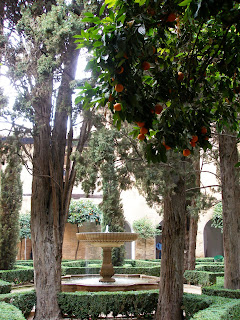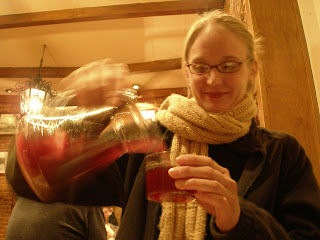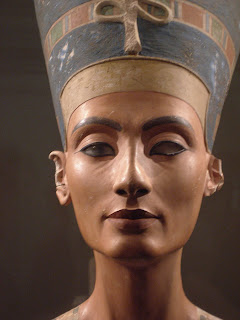Well, eventually, Anna had to go home. *frown* But then my friend Andrew came and we went down to Seville for Holy Week!
I really think that Holy Week (Semana Santa) in Seville deserves some gesture of speechlessness. But leaving out an explanation probably wouldn't work so well on the blog, so, anyway.
Starting on Palm Sunday, the different brotherhoods in Seville make processions through the streets to the cathedral...
 Nazarenes in white robes.
Nazarenes in white robes. There are a lot of Nazarenes walking with each procession (up to a couple thousand), including kids. It's a lot of walking. Each procession starts at the brotherhood's home church, goes to the cathedral, and then goes back to the home church. So, depending on where your home church is, this can be A Lot of walking. I think the longest procession that Andrew and I saw on the schedule was expected to last for 14 hours. The arduous walk is part of the point: the Nazarenes are supposed to be meditative. Their robes and hoods enable meditation and also have a dramatic visual affect on all the people watching in the streets. The hoods come off on Easter Sunday (or, if you're a kid, when the weather gets too hot).

Penitents bearing the cross.
The Penitents are fraternity members like the Nazarenes, and they participate in a physical act of penitence by carrying one (or sometimes two) wooden crosses in the procession. A lot of them go barefoot. We didn't see a lot of kids doing this one.

Paso with Jesus in a purple robe.
So the strange conglomeration of men carrying a wooden scaffold that Anna and I saw in Madrid was actually a fraternity practicing for Semana Santa. With each procession, there are usually two floats (pasos): one with a scene from Jesus' Passion, and one with a figure of Mary mourning her dead son. The floats are decorated with carved wooden figures, flowers, and candles. The Semana Santa tradition goes back to the 1500s, and a lot of the floats are almost that old. Also, some of the floats weigh up to a metric ton...so it takes a lot of coordination and raw muscle mass to haul them down the streets for 14 hours. Each float has about 20-30 guys underneath carrying it on their shoulders.

Drum Line
Each float is followed by a band that plays Fraternity Marches during the procession, and drummers who help keep the pace. The men carrying the floats walk/shuffle exactly in time with the drummers, so that Jesus' robe or Mary's canopy are aways swaying in time with the music. Kind of makes Jesus look like he's walking. Very hypnotic.
 Trumpets
Trumpets Costaleros, off duty.
Costaleros, off duty. Yeah, the costaleros are usually big guys. They always wear four things: headdress, hernia belt, espadrille shoes, and sweat. The roll of fabric in the headdress is where the crossbeam of the float sits on their shoulders. Once they get under the float, pretty much all you can see of them is their feet. They can't see anything either, so there are men that walk along side the float and tell them when to start/stop/turn a corner.

"One's destination is never a place, but rather a new way of looking at things."
Henry Miller

Black robes, too (each fraternity has its own colors).


 Once a procession reaches the cathedral, everyone (including the float) goes into the church for a blessing.
Once a procession reaches the cathedral, everyone (including the float) goes into the church for a blessing. "Behold, I stand at the door and knock; if anyone hears My voice and opens the door, I will come in."
"Behold, I stand at the door and knock; if anyone hears My voice and opens the door, I will come in." 